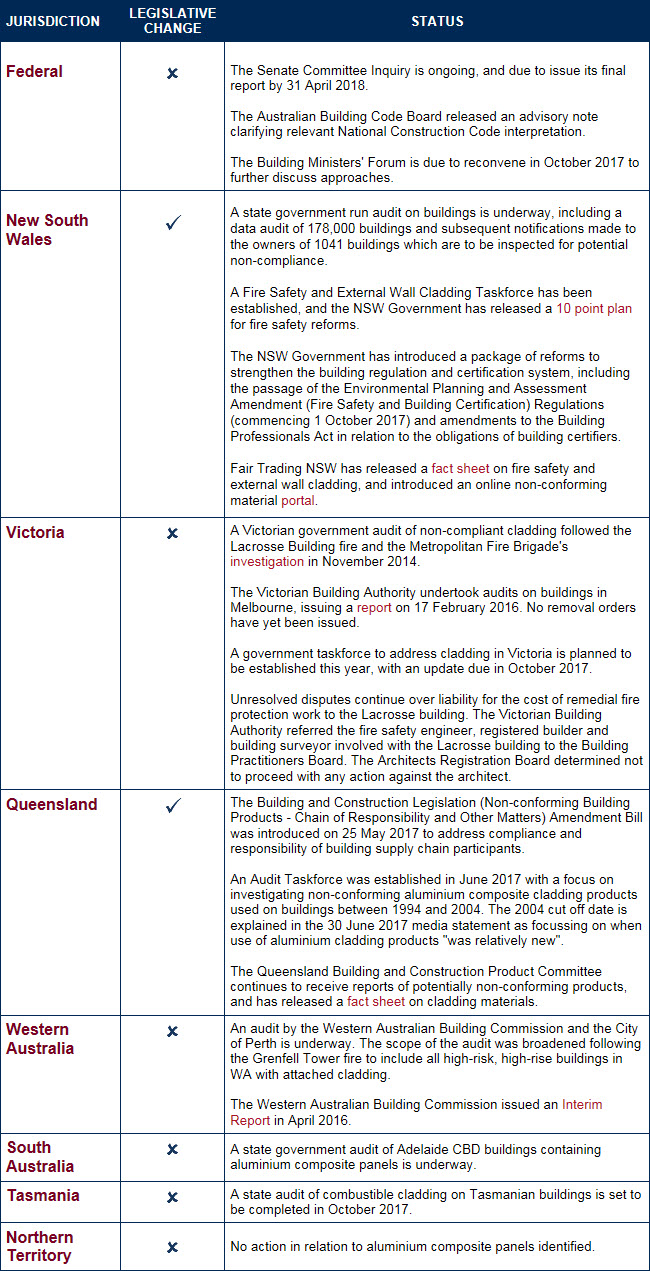10 October, 2017
In May 2015 we reported on the issue of non-conforming and non-compliant building products in the Australian construction industry. The Grenfell Tower fire disaster in London has tragically brought the issue of non-conforming building products to public attention, particularly in respect of polyethylene (PE) core aluminum composite cladding used on high rise buildings. As with the Lacrosse building fire in Melbourne in 2014, the use of this highly flammable type of cladding led to the rapid spread of the fire at Grenfell Tower.
Public interest in this issue continues, including with the recent ABC Four Corners program titled "Combustible". The Four Corners investigation indicated the widespread use of PE, a by-product of the petrochemical industry, in aluminium cladding across Australia over the last 30 years. The product has been connected to fires in Australia, Dubai, China, England and France.
The Senate Standing Committee report has recognised a range of issues specific to Australia's building and construction industry, including confusion surrounding the regulation of materials, a lack of enforcement and the absence of national licensing schemes. Alongside this, deregulation and self-accreditation within the industry has reduced accountability across the supply chain, leaving pressing questions of liability largely unresolved.
This legal alert includes a jurisdiction-by-jurisdiction summary of current responses to this issue.
Senate Standing Committee recommendations
The Senate Standing Committee on Economics released its interim report on 6 September 2017 in relation to aluminum composite cladding, and made eight key recommendations in its report. Critically, the Committee recommended that a total ban on the importation, sale and use of PE core aluminum composite cladding be implemented as a matter of urgency.
The Committee formed the view, in light of the Grenfell Tower fire, that there are no legitimate uses of PE core aluminium composite cladding on any type of building in Australia. This is despite the fact that PE cladding can be used in a compliant manner in low rise buildings and signage, as well as through performance based solutions, under the current National Construction Code (NCC).
The NCC is, however, currently being updated in an out-of-cycle amendment likely to take effect in March 2018. The amended NCC will provide a new suite of measures in relation to fire safety in high rise buildings, and certainty as to compliance with existing fire safety measures.
The Committee noted that fire retardant panels are able to be used in the same applications as those with PE cores, and do not significantly increase the costs of construction. One estimate provided to the Committee was that the increased cost of fire retardant panels was only A$3 per sqm.
Coalition Senators on the Committee did not support the ban recommendation, on the basis that products of this nature are regularly used in the signage industry and that banning an individual product would not have an impact on the broader issue of non-compliant and non-conforming building products being used in the Australian construction industry.
Other key recommendations made by the Committee include that:
- a national licensing scheme be introduced in relation to all trades and professionals in the building industry, including builders, project managers, building surveyors and building inspectors, to require ongoing professional development;
- further consideration be given to strategies to increase accountability of all stakeholders at each stage of the supply chain (design, manufacture, import, supply and installation) and, in particular, identified the Queensland Building and Construction Legislation (Non-conforming Building Products – Chain of Responsibility and Other Matters) Amendment Bill 2017 currently under consideration as a good example of the types of measures which could be adopted. The Committee noted that any measures adopted ought to be consistent nation-wide;
- the costs to access the NCC, Australian Standards and other building codes be reduced so that it does not act as a barrier to compliance with those codes;
- a regime of penalties be considered in respect of breaches of the NCC, including a ban on tendering for Commonwealth-funded construction work; and
- the State and Territory governments consider adopting a nationally consistent statutory duty of care for the owners of residential properties.
It remains to be seen whether the Senate inquiry into non-conforming building products will recommend the banning of other non-conforming or non-complying building products, or otherwise adopt these recommendations more broadly.
The Senate is due to issue a further interim report into asbestos on 31 October 2017, and its final report on 31 April 2018. The Senate Committee's final report will be provided nearly three years later than originally anticipated, as it was initially due to report in June 2015, but was granted numerous extensions and was also delayed by the 2015 Federal election.
Federal response to the issue of non-conforming building products
While the management of building and construction is a matter for the States and Territories, the Federal Government has taken steps to address the issue of non-compliant and non-conforming building products, in parallel with the Senate Committee inquiry.
In July 2017, the Federal Government established a website dedicated to providing information and resources to the industry in respect to non-conforming building products. The website also allows members of the industry and general public to submit complaints or queries regarding any product or material, and is part or the broader strategy towards greater supervision and transparency in the building industry.
It is also understood that the Federal Government requested each State and Territory to undertake an audit of its high rise buildings to ascertain the extent to which the flammable cladding had been used in construction.
Response of the States and Territories
The table below sets out the responses of each of the States and Territories to the issue of non-conforming and non-compliant building products. Most immediately, the Lacrosse building fire and the Grenfell Tower fire prompted all Australian States and Territories (except the Northern Territory) to audit the use of aluminium composite panels.
Queensland has been the most active in addressing this issue, with the Building and Construction Legislation (Non-conforming Building Products – Chain of Responsibility and Other Matters) Amendment Bill 2017 (the Bill) seeking to improve accountability of all participants in the building products supply chain. The Bill imposes responsibility on all supply chain participants to ensure that non-conforming building products are not used in construction in Queensland by imposing duties on each of those participants and creating new offences relating to a breach of those duties. Equally, the Bill seeks to create greater transparency throughout the supply chain through improved notification and reporting requirements.
As mentioned above, the Bill was noted by the Senate Standing Committee as a recommended legislative regime for improving the safety of Australian buildings.
Commercial pressures are also influencing the treatment of the PE cladding issue in parallel with legislative and regulatory changes. Financier and insurer requirements are likely to prove equally influential. Developers, owners and potential purchasers may find that PE clad buildings are subject to refusal of finance or insurance, increased insurance premiums and/or excesses, coverage exclusions, mandated investment in additional fire protection upgrades and impaired asset valuations. Media reports that Westpac has demanded an audit of all planned and under-construction residential and commercial projects for compliance of external wall cladding with the provisions of the National Construction Code are an indication of heightened financier focus on these risks.*
Please click on the table to enlarge.
*AFR, 12 September 2017, "Cladding concerns grow: Westpac auditing new, current projects for compliance"
For further information, please contact:
Alex Hartmann, Partner, Baker & McKenzie
alex.hartmann@bakermckenzie.com






